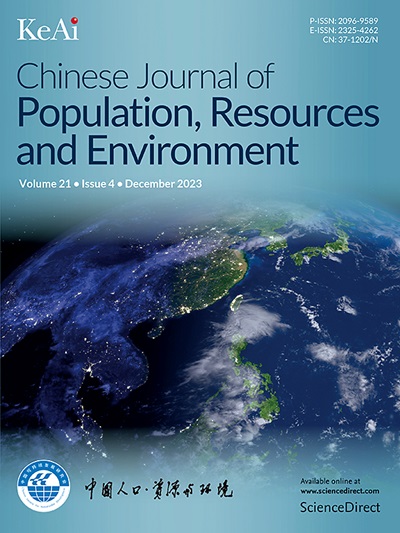Spatiotemporal patterns and spatial dislocation with economic level of China’s ecological resilience
IF 4.8
4区 环境科学与生态学
Q2 ENVIRONMENTAL STUDIES
Chinese Journal of Population Resources and Environment
Pub Date : 2025-03-01
DOI:10.1016/j.cjpre.2025.01.004
引用次数: 0
Abstract
Ensuring a harmonious coexistence between man and nature is crucial for China’s economic and social development. However, with increasing industrialization and urbanization, there is a growing mismatch between China’s ecological resilience (ER) and economic level (EL) of development, which poses a notable social threat. Currently, the link between ER and EL in China remains unclear, especially in terms of spatial dislocation (SD), referring to the disconnect between the locations where environmental impacts occur and those where economic benefits or activities are concentrated. Therefore, this paper aims to provide theoretical support and an empirical basis for policy-based solutions to address this gap. Based on the SD theory, this study systematically discusses the temporal changes, spatial patterns, and SD characteristics of China’s ER and EL using spatial auto-correlation and barycentric analysis to analyze data from 30 provinces covering the period 2011–2021. The key results are as follows. China’s ER shows a general trend of growth; however, its distribution is uneven. The spatial pattern generally decreases from the southeastern coastal provinces to the northwest. Moreover, a gradually increasing positive correlation is observed between the ER and EL, but this correlation varies by region, with some showing regional linkages and others developing independently. Finally, the dislocation index of ER and EL presents divergent results based on region—the eastern and central regions primarily show a high level of dislocation, whereas the western and northeastern regions show a low level of dislocation. The results provide a comprehensive overview of the spatiotemporal patterns in the association between ER and EL in China. The results emphasize that to balance sustainable regional development and ecological governance, a region-specific approach must be employed, prioritizing innovation-driven strategies for high ER in more developed regions and market-oriented strategies in less developed regions.
中国生态弹性的时空格局及空间错位与经济水平
坚持人与自然和谐相处,是中国经济社会发展的根本要求。然而,随着工业化和城市化进程的加快,中国的生态弹性与经济发展水平之间的不匹配现象日益严重,构成了显著的社会威胁。目前,中国生态承载力与经济效益之间的联系尚不明确,特别是在空间错位(SD)方面,即环境影响发生地与经济效益或活动集中地之间的脱节。因此,本文旨在为解决这一差距的政策解决方案提供理论支持和实证依据。基于标准差理论,采用空间自相关和质心分析方法,系统探讨了2011-2021年中国30个省份的经济数据的时空变化、空间格局和标准差特征。主要结果如下。中国的急诊室总体呈增长趋势;然而,其分布是不平衡的。空间格局总体上由东南沿海省份向西北省份递减。此外,厄尔尼诺与厄尔尼诺之间的正相关性逐渐增强,但这种相关性因区域而异,有的表现出区域联系,有的表现出独立发展。最后,ER和EL的位错指数在区域上呈现出不同的结果,东部和中部地区主要表现为高位错,而西部和东北部地区表现为低位错。研究结果全面揭示了中国厄尔尼诺现象与厄尔尼诺现象的时空关系。研究结果表明,要实现区域可持续发展与生态治理之间的平衡,必须采取有区域特色的方法,在高生态效益地区优先采用创新驱动战略,在低生态效益地区优先采用市场导向战略。
本文章由计算机程序翻译,如有差异,请以英文原文为准。
求助全文
约1分钟内获得全文
求助全文
来源期刊

Chinese Journal of Population Resources and Environment
ENVIRONMENTAL STUDIES-
CiteScore
4.30
自引率
1.10%
发文量
791
审稿时长
79 days
期刊介绍:
The Chinese Journal of Population, Resources and Environment (CJPRE) is a peer-reviewed international academic journal that publishes original research in the fields of economic, population, resource, and environment studies as they relate to sustainable development. The journal aims to address and evaluate theoretical frameworks, capability building initiatives, strategic goals, ethical values, empirical research, methodologies, and techniques in the field. CJPRE began publication in 1992 and is sponsored by the Chinese Society for Sustainable Development (CSSD), the Research Center for Sustainable Development of Shandong Province, the Administrative Center for China's Agenda 21 (ACCA21), and Shandong Normal University. The Chinese title of the journal was inscribed by the former Chinese leader, Mr. Deng Xiaoping. Initially focused on China's advances in sustainable development, CJPRE now also highlights global developments from both developed and developing countries.
 求助内容:
求助内容: 应助结果提醒方式:
应助结果提醒方式:


